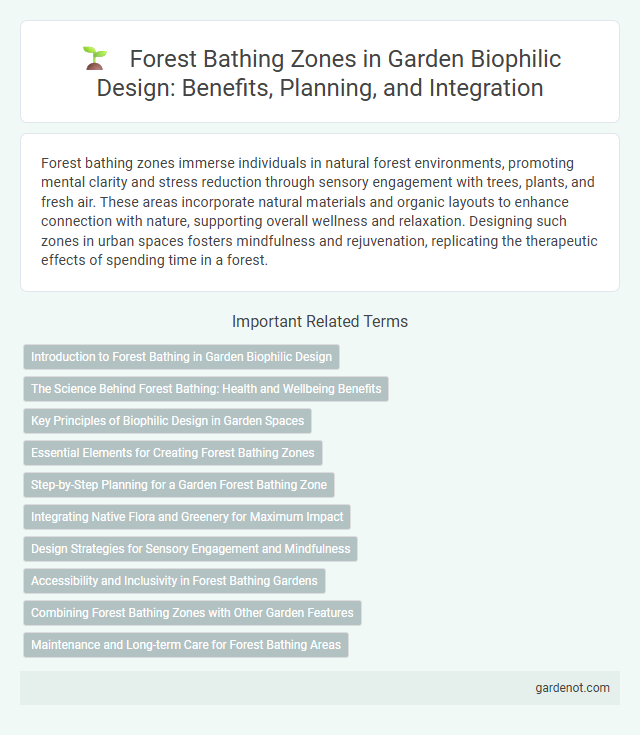Forest bathing zones immerse individuals in natural forest environments, promoting mental clarity and stress reduction through sensory engagement with trees, plants, and fresh air. These areas incorporate natural materials and organic layouts to enhance connection with nature, supporting overall wellness and relaxation. Designing such zones in urban spaces fosters mindfulness and rejuvenation, replicating the therapeutic effects of spending time in a forest.
Introduction to Forest Bathing in Garden Biophilic Design
Forest bathing, or Shinrin-yoku, integrates immersive nature experiences into garden biophilic design by creating zones that mimic dense woodland environments. This practice reduces stress, enhances mood, and supports mental well-being through sensory engagement with natural elements like trees, foliage, and fresh air. Incorporating forest bathing zones in gardens strengthens human-nature connections and promotes holistic health by facilitating mindful interaction with green spaces.
The Science Behind Forest Bathing: Health and Wellbeing Benefits
Forest bathing, rooted in Japanese Shinrin-yoku, scientifically enhances mental clarity by reducing cortisol levels and lowering blood pressure through immersive exposure to natural forest environments. Research from the University of Tokyo demonstrates that phytoncides, organic compounds released by trees, boost immune function by increasing natural killer cell activity. Neuroscientific studies reveal that sensory interaction with forest elements stimulates the parasympathetic nervous system, promoting relaxation and reducing symptoms of anxiety and depression.
Key Principles of Biophilic Design in Garden Spaces
Forest bathing zones in garden spaces emphasize immersion in natural elements, incorporating lush vegetation, natural materials, and water features to stimulate the senses and promote wellbeing. Key principles of biophilic design include creating layered plantings for complexity, maximizing natural light and airflow, and fostering a strong connection to nature through multisensory experiences. These elements enhance psychological restoration, reduce stress, and improve overall health by replicating the innate human affinity for natural environments.
Essential Elements for Creating Forest Bathing Zones
Essential elements for creating forest bathing zones include dense native vegetation that promotes sensory engagement through sight, sound, and scent, enhancing the restorative experience. Incorporating natural materials such as wood and stone paths supports immersion in the environment while minimizing ecological impact. Water features and varied topography further stimulate mindfulness and connection to nature, essential for effective forest bathing.
Step-by-Step Planning for a Garden Forest Bathing Zone
Creating a forest bathing zone begins with selecting native plant species to enhance biodiversity and promote ecological balance. Design pathways with natural materials to encourage slow, mindful walking while integrating seating areas for immersive relaxation and sensory engagement. Incorporate water features and varied terrain to stimulate multiple senses, supporting mental restoration and stress reduction in the garden space.
Integrating Native Flora and Greenery for Maximum Impact
Integrating native flora and greenery in a Forest Bathing Zone enhances ecological authenticity and supports local biodiversity by providing natural habitats for indigenous wildlife. Utilizing regional plant species ensures optimal adaptation to the environment, promoting sustainable growth and reducing maintenance. This strategic incorporation fosters a deeply immersive, therapeutic experience aligned with biophilic design principles, maximizing mental and physical wellness benefits.
Design Strategies for Sensory Engagement and Mindfulness
Forest bathing zones incorporate natural materials, such as wood and stone, paired with lush greenery to enhance tactile and visual sensory engagement. Design strategies emphasize creating varied textures, subtle soundscapes like rustling leaves, and controlled light filtering through canopy simulations to promote mindfulness. Integrating natural scents and water features supports a multisensory environment that deepens relaxation and presence.
Accessibility and Inclusivity in Forest Bathing Gardens
Forest bathing zones prioritize accessibility by incorporating wide, smooth pathways and sensory-friendly design elements to accommodate diverse mobility needs and sensory sensitivities. Inclusive forest bathing gardens integrate native plant species and interactive features that engage all ages and abilities, fostering a sense of connection to nature. Visual, auditory, and tactile cues enhance navigability and participation, ensuring a welcoming environment for individuals with disabilities.
Combining Forest Bathing Zones with Other Garden Features
Integrating forest bathing zones with elements like meditation gardens, water features, and native plant collections enhances sensory immersion and promotes holistic well-being. Strategic placement of seating areas amid diverse flora amplifies restorative experiences by encouraging mindfulness and relaxation. Combining these features supports biodiversity while creating multifunctional green spaces that foster physical and mental health benefits.
Maintenance and Long-term Care for Forest Bathing Areas
Maintaining forest bathing zones requires regular monitoring of soil health, native vegetation, and water quality to preserve the ecosystem's balance and therapeutic benefits. Long-term care involves invasive species control, trail erosion prevention, and sustainable waste management practices to ensure a safe, serene environment for visitors. Implementing adaptive management strategies supports resilience against climate change effects and fosters ongoing biodiversity conservation within the forest bathing area.
Forest bathing zone Infographic

 gardenot.com
gardenot.com